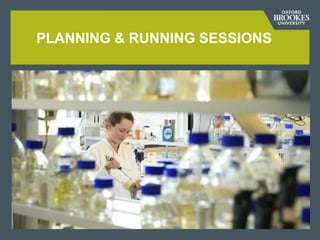
Planning & running sessions
- 1. PLANNING & RUNNING SESSIONS
- 2. OUTCOME Design and deliver a session that uses a variety of teaching techniques
- 3. OUTLINE Using resources / being creative Getting Engagement Group work Questions
- 4. WHAT MAKES A GOOD LECTURER? “Enthusiasm, approachable, understand the learning perspective of students, give their time after lectures, open-minded, motivated, engage in a process of sharing, passion.” Rieutort-Louis (2009) What Makes a Good Lecturer? Academy Exchange Issue 8
- 5. REMEMBER: GOOD PRACTICE • encourage student-tutor contact • encourage student-student co-operation • encourage active learning • give prompt feedback • emphasise time on task • have and communicate high expectations • respect diverse talents and ways of learning (Chickering & Gamson, 1987)
- 6. USING RESOURCES: SOME EXAMPLES Chemical engineering lecture using a home-made model to demonstrate key principles http://www.nottingham.ac.uk/pesl/resources/large group/demonstr677/ Being creative in lectures (from a PgCert participant)http://www.youtube.com/watch?v=H51C MP9rScs Example from Biology http://www.nottingham.ac.uk/pesl/resources/large group/demonstr559/
- 7. BEING CREATIVE In pairs, think about how you could use an item that you have on you or is in the room for your teaching. Which concept could they help illustrate? Prepare to teach the concept using the resource (max 1 minute) What other simple resources do you have at home that you could use in your teaching?
- 9. GETTING ENGAGEMENT: ACTIVITY Quizzes Short writing activity Short reading activity (e.g. read an article) Debate / student presentations (prepared in advance for a particular session) Write own exam question based on material presented earlier in lecture. (1 minute paper) Pair discussion, Buzz groups, Snowballing, syndicate groups.
- 10. LEARNING IN GROUPS Theories on how to foster collaboration suggest that secrets to success include: 1. Encouraging your students to explore how they work in a group 2. Helping your students to improve how they work in a group by knowing their strengths and weaknesses 3. Being clear about your main aim for group work 4. Being clear about the procedures for group work
- 11. LEARNING IN GROUPS: WHY? Students are required to be proactive Prepares students for collaborative working in their future professions Group teaching in which students collaborate to solve problems can be more efficient than lecture formats, e.g. Problem Based Learning
- 12. ADVANTAGES & CHALLENGES In groups, discuss and produce a „poster‟ on the advantages and challenges of group work.
- 13. LEARNING IN GROUPS: ADVANTAGES
- 14. LEARNING IN GROUPS: CHALLENGES See Jaques, D. (2003) „Teaching in small groups.‟ BMJ 326 (1): 492-4
- 15. SUMMARY: PLANNING & STRUCTURING A SESSION Think: What learning are you trying to stimulate? What added value is there in your presence? Do: Break the session up with into sections, provide opportunity for student –lecturer & student – student interaction, be explicit. Remember: what are you doing? What are students doing?
- 16. SUMMARY: SIX POWERFUL FORCES IN EDUCATION Activity Expectations Cooperation Interaction Diversity Responsibility Chickering and Gamson (1987) "Seven principles for good practice in undergraduate education" American Association of Higher Education Bulletin vol.39 no.7 pp.3-7
- 17. PRACTICAL CONCERNS In groups, discuss any examples of situations you have faced in teaching or any concerns you have. What advice can you give each other?
Notes de l'éditeur
- Get them to give examples of techniquesQuestioning: give students time to think, get them to discuss in pairs first, get them to write an answer down first, multi-choice (show of hands)
- Get them to complete. Could include - Students can take risksShy students may get more involved Students get immediate peer and tutor feedbackThere is a leveling of relationships and informalityStudents are more responsible and less able to hide! There are opportunities for interactionGroup work can be diagnosticGroup work provides space for students to think, generate and share opinions,We can get to know our students betterWe can encourage individuals an build confidenceWe can promote co-construction of group knowledge and identityGroups promote student-centred and student-led learning
- Freeriding, Distraction from the task , Delegate responsibility for group interaction (and therefore for learning) to studentsStudents will not talk to each other, but will only respond to questions from the tutorStudents do not prepare for the sessionsOne student dominates or blocks the discussionThe students want to be given the solutions to problems rather than discuss them
